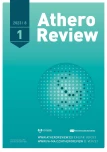Cardiovascular risk: from meaning to determination to communication with the patient
Authors:
Michal Vrablík
Authors‘ workplace:
Centrum preventivní kardiologie, III. interní klinika – endokrinologie a metabolismu 1. LF UK a VFN v Praze
Published in:
AtheroRev 2023; 8(1): 17-24
Category:
Reviews
Overview
The approach to cardiovascular (CVD) disease prevention is changing. The recommended procedures postulate increasingly ambitious target values, to achieve which we have a number of new treatment options available. CV risk assessment remains the basis for the choice of treatment interventions. For this, we use the SCORE 2 and SCORE OP tables from 2021 for asymptomatic persons. Although the new algorithms have made the risk estimate more accurate in marginal groups of patients, it is true that they can significantly underestimate the real long-term risk. In addition, the presentation of the chance of a vascular event in the order of individual percentages is often not a strong enough motivation for changing lifestyle or starting drug therapy. Misunderstanding negatively affects the adherence of such patients. In addition to communicating long-term cardiovascular risk, we can use the concept of vascular age to improve patient acceptance. This simplifies the explanation of the concept of risk and demonstrably increases the proportion of patients who adhere to treatment measures. Together with the promotion of the principles of rational pharmacotherapy with the maximum use of fixed combinations for the intervention of the main risk factors of CV disease, the procedures described above belong to the foundations of the strategy for improving the results of CV prevention.
Keywords:
prevention – arterial hypertension – vascular age – dyslipidemia – cardiovascular risk
Sources
1. Češka R. Cholesterol a ateroskleróza, léčba dyslipidémií. Triton: Praha 2012. ISBN 9788073875992.
2. Ressia A, Dell’Oca N, Reyes X et al. Cumulative LDL-C burden as a CVD risk predictor on familial hypercholesterolemia. Atherosclerosis 2018 : 275: E81-E82. Dostupné z DOI: <https://doi.org/10.1016/j.atherosclerosis. 2018.06.226>.
3. Mach F, Baigent C, Catapano AL et al. [ESC Scientific Document Group]. 2019 ESC/EAS Guidelines for the management of dyslipidaemias: lipid modification to reduce cardiovascular risk. Eur Heart J 2020; 41(1):111–188. Dostupné z DOI: <http://dx.doi.org/10.1093/eurheartj/ehz455>.
4. Pollock BD, Stuchlik P, Harville EW et al. Life course trajectories of cardiovascular risk: Impact on atherosclerotic and metabolic indicators. Atherosclerosis 2019; 280 : 21–27. Dostupné z DOI: <http://dx.doi.org/ 10.1016/j.atherosclerosis.2018.11.008>.
5. Teo K, Lear S, Islam S, Mony P et al PURE Investigators. Prevalence of a healthy lifestyle among individuals with cardiovascular disease in high-, middle - and low-income countries: The Prospective Urban Rural Epidemiology (PURE) study. JAMA 2013; 309(15): 1613–1621. Dostupné z DOI: <http://dx.doi.org/10.1001/jama.2013.3519>.
6. Piepoli MF, Hoes AW, Agewall S et al. 2016 European Guidelines on cardiovascular disease prevention in clinical practice: The Sixth Joint Task Force of the European Society of Cardiology and Other Societies on Cardiovascular Disease Prevention in Clinical Practice (constituted by representatives of 10 societies and by invited experts) Developed with the special contribution of the European Association for Cardiovascular Prevention & Rehabilitation (EACPR). Eur Heart J 2016; 37(29): 2315–2381. Dostupné z DOI: <http://dx.doi.org/10.1093/eurheartj/ehw106>.
7. Visseren FL, Mach F, Smulders YM et al. [ESC Scientific Document Group]. 2021 ESC Guidelineson cardiovascular disease prevention in clinical practice. Eur J Prev Cardiol 2022; 29(1): 5–115. Dostupné z DOI: <http:// dx.doi.org/10.1093/eurjpc/zwab154>.
8. Vrablík M, Piťha J, Blaha V et al. Stanovisko výboru České společnosti pro aterosklerózu k doporučením ESC/EAS pro diagnostiku a léčbu dyslipidemií z roku 2019. AtheroRev 2019, 4(3): 126–137.
9. Cuende JI, Cuende N, Calaveras-Lagartos J. How to calculate vascular age with the SCORE project scales: a new method of cardiovascular risk evaluation. Eur Heart J 2010; 31(19): 2351–2358. Dostupné z DOI: <http:// dx.doi.org/10.1093/eurheartj/ehq205>.
10. Lopez-Gonzalez AA, Aguilo A, Frontera M et al. Effectiveness of the Heart Age tool for improving modifiable cardiovascular risk factors in a Southern European population: a randomized trial. Eur J Prev Cardiol 2015; 22(3): 389 – 396. Dostupné z DOI: <http://dx.doi.org/10.1177/2047487313518479>.
11. Ference BA, Bhatt DL, Catapano AL et al. Association of Genetic Variants Related to Combined Exposure to Lower Low-Density Lipoproteins and Lower Systolic Blood Pressure With Lifetime Risk of Cardiovascular Disease. JAMA 2019; 322(14): 1381–1391. Dostupné z DOI: <http://dx.doi. org/10.1001/jama.2019.14120>.
12. Gupta A, Mackay J, Whitehouse A et al. Long-term mortality after blood pressure-lowering and lipid-lowering treatment in patients with hypertension in the Anglo-Scandinavian Cardiac Outcomes Trial (ASCOT) Legacy study: 16-year follow-up results of a randomised factorial trial. Lancet 2018; 392(10153): 1127–1137. Dostupné z DOI: <http://dx.doi.org/10.1016/ S0140–6736(18)31776–8>. Erratum in Lancet 2018; 392(10156): 1402. Dostupné z DOI: <http://dx.doi.org/10.1016/S0140–6736(18)32517–0>.
13. Margolis KL, Davis BR, Baimbridge C et al. Long-term follow-up of moderately hypercholesterolemic hypertensive patients following randomization to pravastatin vs usual care: the Antihypertensive and Lipid-Lowering Treatment to Prevent Heart Attack Trial (ALLHAT-LLT). J Clin Hypertens 2013; 15(8): 542–554. Dostupné z DOI: <http://dx.doi.org/10.1111/jch.12139>.
14. Kostis WJ, Moreyra AE, Cheng JQ et al. Continuation of mortality reduction after the end of randomized therapy in clinical trials of lipid-lowering therapy. J Clin Lipidol 2011; 5(2): 97–104. Dostupné z DOI: <http://dx.doi. org/10.1016/j.jacl.2011.01.006>.
15. Ford I, Murray H, McCowan C et al. Long term safety and efficacy of lowering LDL-cholesterol with statin therapy: 20-year follow up of West of Scotland Coronary Prevention Study. Circulation 2016; 133(11): 1073–1080. Dostupné z DOI: <http://dx.doi.org/10.1161/CIRCULATIONAHA. 115.019014>.
Labels
Angiology Diabetology Internal medicine Cardiology General practitioner for adultsArticle was published in
Athero Review

2023 Issue 1
Most read in this issue
- How to make treatment faster than atherosclerosis
- Cardiovascular risk: from meaning to determination to communication with the patient
- Lipitension: new options of combination therapy
- The 95th percentile of LDL-cholesterol in the Czech population: The Czech post- MONICA study
